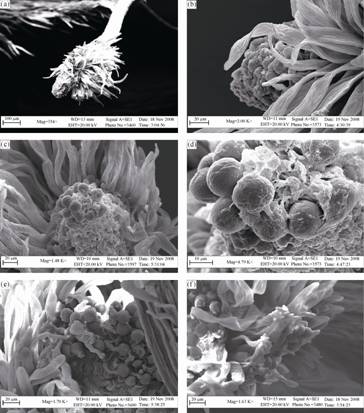Breeding System and its Consequence on Fruit Set of Eremosparton songoricum
2011-11-21
Rare species, the coincidence of diversity hotspots and conservation strategies, have been considered more and more importance in the last 20 years. Eremosparton songoricum (Litv.) Vass. is a rare, dwarf shrubby legume occurring in severely wind eroded moving and semi-moving sand dunes of the Gurbantunggut Desert, Xinjiang, China, and sand dunes around Lake Balkash in Kazakstan. E. songoricum belongs to the genus Eremosparton, tribe Galegeae in the Papilionoideae.
An individual can produce 100–3,000 flowers based on plant size. Moreover, the seed germination rate in the wild was lower than 3% and the seedling establishment rate was lower than 0.1%.Those seemed to indicate that some weaknesses existed in the sexual reproductive cycle. Besides, the distribution area of E. songoricum is fragmented, and the population size has greatly decreased during the past 50 years. With the decreasing population size, selfing rates can be high and embryos suffer from reduced fitness. However, till now, the breeding system, core content on reproductive success of a rare species, had not been reported for E. songoricum, and its consequence on fruit set is also still unclear. Under these circumstances, the elucidation of the breeding system and its consequences on reproductive success of such a rare sand dune shrub as E. songoricum has become much more importance.
In order to examine the mating system of E. songoricum, check for the existence of specialized pollen release and reception mechanisms which affect the breeding procedure, and evaluate the influence of pollinators on reproductive success in a desert habitat, Prof. ZHANG Daoyuan and her research team examined E. songoricum by manipulative experiments and observational studies in natural populations during the period of 2007–2009.
The results showed that E. songoricum exhibits a mixed mating system. It is self-compatible, but depends strictly on pollinators to set fruits. Only two effective pollinators were detected and they triggered the specialized pollination mechanism (a ‘brush type’ and ‘tripping mechanism’). Geitonogamy becomes predominant in natural populations, because (74.5±1.3)% of visiting activity happened within or between inflorescences and (24.3±1.4)% occurred between ramets. As a result, inbreeding depression caused by geitonogamous selfing inevitably happened under natural conditions, showing 2.36 times less fruit set than was achieved by hand cross-pollination. The results explained the rarity of the species due to its breeding system, and will assist to develop suitable conservation strategies in severe desert environments.
This work was supported by the National Natural Science Foundation of China (30970547, 31070472) and the National Basic Research Program of China (2009CB825104). The findings have been published on Journal of Arid Land, 2011, 3(4): 231-239. The paper is also archived at http://jal.xjegi.com/EN/abstract/abstract97.shtml.

SEM photomicrographs of the pollen brush of E. songoricum. (a) The morphology of stigma (right arrow) and stylar brush (left arrow); (b) An intact stigmatic surface (arrow); (c) A tripped stigmatic surface (right arrow) with germinated pollen (left arrow); (d) Stigmatic fluids appear after tripping (arrow); (e) Germinated pollen grains (right arrow) with pollen tube growth (left arrows); (f) Detail of the stylar brush, with pollen grains trapped in the trichomes (arrows).



